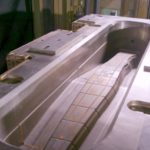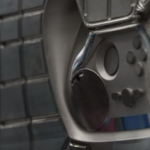Concrete Stools – Max Lamb
Max Lamb
Design Miami/Basel 2008
Solids of Revolution
Solids of Revolution are two collections of stools in concrete and wool felt formed using rotational cutting processes. Two inherently disparate materials unified by property and by process. Hard, heavy concrete becomes lightweight and malleable. Soft, supple wool becomes rigid and strong. The convergence of two polar opposites at a state of physical property where the same processes apply.
Both collections are made from preformed objects designed for industrial applications, offering primary function to otherwise secondary articles. The humble concrete block used to build family dwellings and architectural monoliths, and discs of pressed wool felt that are mounted onto a rotational spindle for use in the metal, glass and stone polishing industry.
Solid of Revolution describes a solid object obtained by rotating a plane profile around an axis, an expression that simulates both the process of turning on a lathe and the rotational aspect of a felt polishing disc.
Concrete Stools.
Autoclaved Cellular Concrete is a foamed concrete containing a high volume of air in a cell-like structure. The material is five times lighter than concrete, highly insulating and easily machined making it perfect for turning on a lathe.
Concrete Stools are turned from a complete palette of 18 autoclaved cellular concrete blocks 32 x 32 x 62cm in size. These blocks present perfect dimensions for a seat surface and sitting height and can be mounted onto a lathe and formed using traditional wood-turning tools. Every stool is unique and none were predetermined. Each stool a consequence of that preceding it.
By Max Lamb



